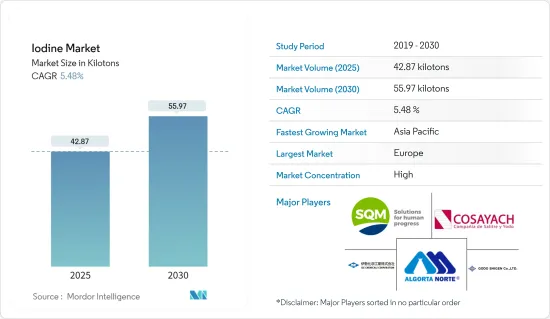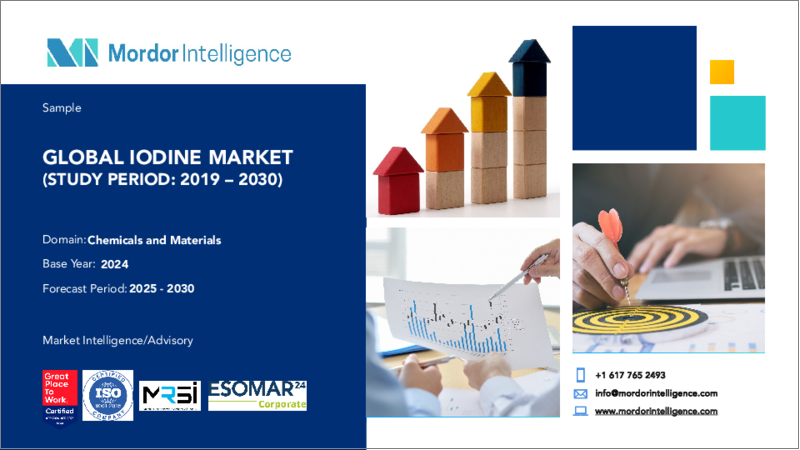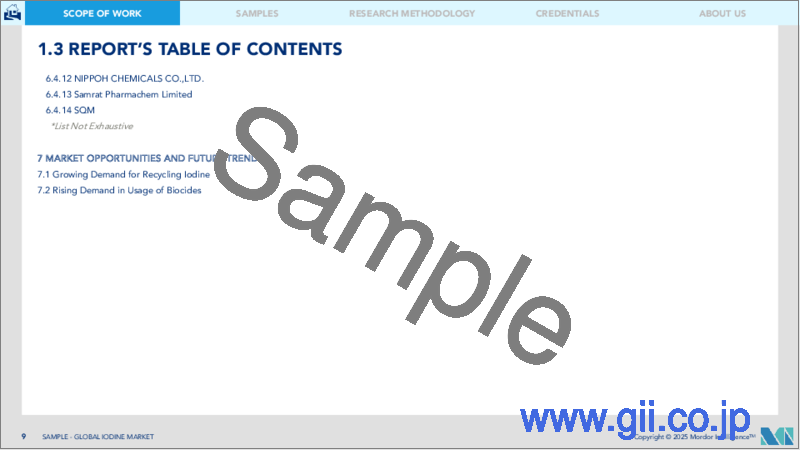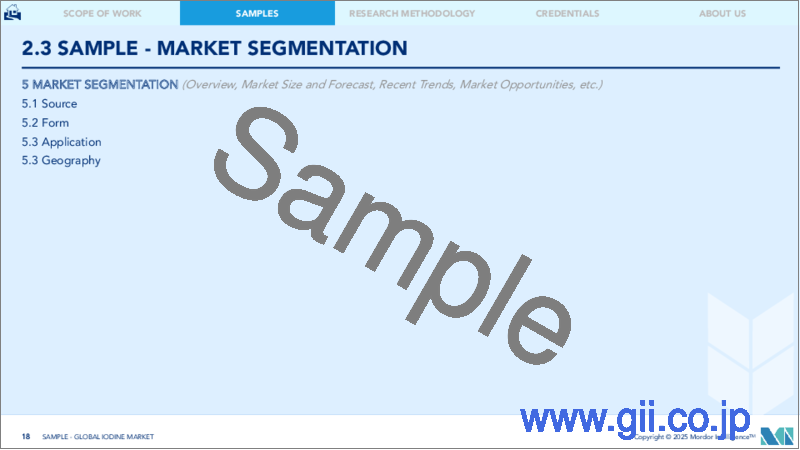|
|
市場調査レポート
商品コード
1689910
ヨウ素:市場シェア分析、産業動向・統計、成長予測(2025年~2030年)Iodine - Market Share Analysis, Industry Trends & Statistics, Growth Forecasts (2025 - 2030) |
||||||
カスタマイズ可能
適宜更新あり
|
|||||||
| ヨウ素:市場シェア分析、産業動向・統計、成長予測(2025年~2030年) |
|
出版日: 2025年03月18日
発行: Mordor Intelligence
ページ情報: 英文 120 Pages
納期: 2~3営業日
|
全表示
- 概要
- 目次
ヨウ素の市場規模は2025年に42.87キロトンと推定され、予測期間(2025-2030年)のCAGRは5.48%で、2030年には55.97キロトンに達すると予測されています。

COVID-19はヨウ素市場にマイナスの影響を与えました。その主な原因は、規制の強化や製造装置の大規模な操業停止でした。しかし、規制が解除されて以来、ヨウ素製品に対する需要が増加しているため、ヨウ素市場も成長しており、予測期間中も同様の軌道をたどる可能性が高いです。
主なハイライト
- 短期的には、X線造影剤需要の増加と、ヨウ素欠乏症の増加に伴うヨウ素摂取需要の増加がヨウ素需要を牽引するとみられます。
- しかし、ヨウ素の毒性と過剰摂取による健康関連の問題が、調査した市場成長の主な抑制要因となっています。
- その一方で、殺生物剤におけるヨウ素の需要の高まりと、ヨウ素のリサイクル需要の増加は、今後数年間で有利な市場機会を生み出す可能性が高いです。
- 欧州はヨウ素の最大市場として浮上し、アジア太平洋は2024年から2029年の間に最も高い成長が見込まれています。
ヨウ素市場の動向
医療用セグメントが市場を独占する見込み
- ヨウ素は医療産業において重要な要素であり、診断や治療に多くの用途があります。最も一般的な用途は、防腐剤や消毒剤の製造であり、ヨウ素の細菌、ウイルス、真菌を殺す能力は、感染症を予防する効果的なツールとなっています。
- さらにヨウ素は、CTスキャン、X線、血管造影などの医療用画像処理に使用される放射線造影剤の製造にも使用されます。これらの材料にはヨウ素原子が含まれており、X線を吸収し、得られた画像で身体の内部構造を見えるようにします。
- ヨウ素は原子番号が高く、毒性が低く、有機化合物との接合が容易であるため、X線造影剤のニーズが高まるにつれて需要が増加しています。
- ヨウ素は、自治体の水処理が信頼できない地域を旅行したり働いたりする人々にとって、簡便で効果的、かつコスト効率の高い水消毒手段です。飲料水の消毒に関しては、ヨウ素は緊急時や旅行者に錠剤や溶液の形で一般的に使用されています。近年、旅行者の増加に伴い、消毒剤としてのヨウ素の需要も増加しています。
- 2024年1月、メリーランド大学医学部によると、メリーランド大学医学部の研究者が共同主導した大規模な多施設臨床試験で、ヨウ素を含む消毒薬(アルコール中のヨウ素ポバクリレックス)は、頻繁に使用される別の皮膚消毒薬と比較して、四肢骨折患者の術後感染症が約4分の1に減少することが判明しました。
- 2024年1月、中国核工業集団公司(CNNC)は、強力な溶液型医療用アイソトープ試験炉の建設を開始しました。この構想では、他の医療用アイソトープの中でもヨウ素131とヨウ素125を製造します。医療用アイソトープとは、医療目的で使用される代表的な放射性同位元素です。例えば、ヨウ素131は放射線治療や画像診断に使われます。また、機能不全に陥った甲状腺組織を破壊したり、その他多くの医療用途にも使用されます。CNNCによると、2027年までに完成すると見積もられている医療用アイソトープ原子炉の完成後、ヨウ素131の年間生産能力は2万キュリーとなり、現在の国内需要を上回る。
- アストラゼネカによると、2024年の医薬品売上高は北米が6,330億米ドルでトップ、次いで欧州連合(英国を除く)が2,870億米ドルで2位、東南アジアと東アジアが2,320億米ドルで続くと予想されています。また、2020年の医薬品への総支出は1兆2,652億米ドルで、2025年には1兆5,950億米ドルの収益が見込まれます。
- したがって、上記の要因から、医療エンドユーザー産業が2024年から2029年にかけてヨウ素市場を独占すると予想されます。
欧州が市場を独占する見込み
- 2024年から2029年にかけて、欧州がヨウ素市場を独占すると予想されます。ドイツ、英国、イタリアなどの国々では、動物飼料、医療、殺生物剤用途でヨウ素の需要が高まっています。
- ドイツ動物飼料協会(DVT)によると、2023年暦年のドイツにおける飼料生産量は2,170万トン(mmt)で、前の12ヵ月より1.6%少ない約36万トン(mt)でした。DVT会長は、前年比の縮小はドイツの飼料セクターにおける長期的な縮小の一部緩和を意味すると発表しました。国内の飼料生産量の減少は、主に養豚用飼料の販売減少によるものです。この部門の2023年の生産量は約50万トン(5.8%)減の800万トンです。
- さらに、ドイツは欧州で最も廃水の再処理・リサイクル率が高い国です。一般家庭や公共施設からの廃水の96%以上が、近隣の下水処理場に排出され、処理されています。同国では下水処理水量が増加しているため、2024年から2029年にかけて、これらのプラントでヨウ素ベースの殺生物剤が大量に使用されると予想されます。
- 医療産業はヨウ素の最大の消費者です。2023年12月に発表された英国製薬工業協会のデータによると、英国のライフサイエンス産業の2022年の売上高は1,081億ユーロ(1,154億米ドル)で、2022年の959億ユーロ(1,023億7,000万米ドル)から13%増加しました。2013年以降、売上高は増加傾向にあったが、2021年から2022年にかけて急激に増加しました。売上高が最も多かったのはバイオ医薬品の中核部門で、ライフサイエンス業界全体の売上高の43%を占めました。次いで、バイオ医薬品サービス・供給部門と医療技術中核部門が続き、それぞれ2022年の売上高の25%を占めました。このような動向は、ヨウ素の消費にも影響を与えます。
- イタリアの製薬産業は、約67,000人の献身的な労働力を擁する、広大で信頼性の高い製造基盤を代表しています。技術的にも先進的で、欧州のみならず世界でも主導的地位を占めています。
- Farmindustria-Prometeia 2023の調査データによると、イタリアの製薬産業はイタリア経済の原動力となっています。2023年には、産業価値は500億ユーロ(553億米ドル)に達します。イタリアの医薬品生産は、欧州の医薬品産業において重要な役割を果たしています。Farmindustria-Prometeia 2023の調査によると、この部門の生産高は2023年に2022年比で7.3%増加しました。
- 上記の要因から、欧州のヨウ素市場は2024年から2029年にかけて大きく成長すると予測されています。
ヨウ素業界の概要
ヨウ素市場は高度に統合されています。同市場の主要企業(順不同)には、SQM SA、ISE CHEMICALS CORPORATION、Cosayach、GODO SHIGEN、Algorta Norteなどがあります。
その他の特典:
- エクセル形式の市場予測(ME)シート
- 3ヶ月間のアナリスト・サポート
目次
第1章 イントロダクション
- 調査の前提条件
- 調査範囲
第2章 調査手法
第3章 エグゼクティブサマリー
第4章 市場力学
- 促進要因
- X線造影剤における需要の増加
- ヨウ素欠乏症の増加
- 抑制要因
- ヨウ素の毒性と健康に関する問題
- 産業バリューチェーン分析
- ポーターのファイブフォース分析
- 供給企業の交渉力
- 買い手の交渉力
- 新規参入業者の脅威
- 代替品の脅威
- 競合の程度
第5章 市場セグメンテーション
- 原料
- 地下塩水
- カリッシュ鉱石
- リサイクル
- 海藻
- 形態
- 無機塩と錯体
- 有機化合物
- 元素と同位体
- エンドユーザー産業
- 動物飼料
- 医療
- 殺生物剤
- 光学偏光フィルム
- フッ素化学
- ナイロン
- その他のエンドユーザー産業
- 地域
- アジア太平洋
- 中国
- インド
- 日本
- 韓国
- その他アジア太平洋地域
- 北米
- 米国
- カナダ
- メキシコ
- 欧州
- ドイツ
- 英国
- イタリア
- フランス
- その他欧州
- 南米
- ブラジル
- アルゼンチン
- その他南米
- 中東・アフリカ
- サウジアラビア
- 南アフリカ
- その他中東とアフリカ
- アジア太平洋
第6章 競合情勢
- M&A、合弁事業、提携、協定
- 市場シェア(%)分析
- 主要企業の戦略
- 企業プロファイル
- Algorta Norte
- Calibre Chemicals Pvt. Ltd
- Cosayach
- Deep Water Chemicals
- Eskay Iodine
- Glide Chem Private Limited
- Godo Shigen Co. Ltd
- Iochem Corporation
- Iofina
- ISE Chemicals Corporation
- Itochu Chemical Frontier Corporation
- K&O Energy Group Inc.
- Nippoh Chemicals Co. Ltd
- Parad Corporation Pvt. Ltd
- Proto Chemical Industries
- Salvi Chemical Industries Ltd
- Samrat Pharmachem Limited
- SQM SA
- TOHO Earthtech Inc.
第7章 市場機会と今後の動向
- ヨウ素のリサイクル需要の増加
- 殺生物剤使用の増加
The Iodine Market size is estimated at 42.87 kilotons in 2025, and is expected to reach 55.97 kilotons by 2030, at a CAGR of 5.48% during the forecast period (2025-2030).

COVID-19 had a negative influence on the market for iodine. It was mostly owing to the enforced limits, as well as large-scale shutdowns of manufacturing units. However, with rising demand for the goods, since the restrictions were lifted, the market for iodine is also growing and is likely to continue a similar trajectory over the projection period.
Key Highlights
- In the short term, the increasing demand for X-ray contrast media and increasing requirements for iodine uptake with growing iodine deficiency among people are expected to drive the demand for iodine.
- However, the toxicity of iodine and health-related issues due to excessive consumption pose major restraints to the studied market growth.
- On the other hand, the rising demand for iodine in biocides and the growing demand for recycling iodine will likely create lucrative market opportunities in the coming years.
- Europe emerged as the largest market for iodine, while Asia-Pacific is expected to witness the highest growth between 2024 and 2029.
Iodine Market Trends
The Medical Segment is Expected to Dominate the Market
- Iodine is a crucial element in the medical industry, with many applications in diagnosis and treatment. Its most common use is in producing antiseptics and disinfectants, where iodine's ability to kill bacteria, viruses, and fungi makes it an effective tool for preventing infections.
- In addition, iodine is used to produce radiocontrast materials, which are used in medical imaging procedures such as CT scans, X-rays, and angiograms. These materials contain iodine atoms, which absorb X-rays and make the internal structures of the body visible in the resulting images.
- The demand for iodine has been increasing over the rising need for X-ray contrast media because of its high atomic number, low toxicity, and ease of adjunction with organic compounds.
- Iodine is a simple, effective, and cost-efficient means of water disinfection for people who travel or work in areas where municipal water treatment is unreliable. In terms of the disinfection of drinking water, iodine is commonly used in the form of tablets or solutions during emergencies and by travelers. As the number of travelers has increased in recent years, the demand for iodine as a disinfectant has also been increasing.
- In January 2024, according to the University of Maryland School of Medicine, a large multicenter clinical trial co-led by the University of Maryland School of Medicine researchers found that an antiseptic containing iodine (iodine povacrylex in alcohol) resulted in about one-quarter fewer post-surgical infections in patients with limb fractures compared to another frequently used skin antiseptic.
- In January 2024, China National Nuclear Corporation (CNNC) started the construction of a powerful solution-type medical isotope test reactor. This initiative will produce Iodine-131 and iodine-125, among other medical isotopes. Medical isotopes are typical radioactive isotopes that are used for medical purposes. For example, iodine-131 is used for radiotherapy or imaging. It can also be used to destroy dysfunctional thyroid tissues and many other medical applications. According to CNNC, after completing the medical isotope reactor, which is estimated to be completed by 2027, it will attain an annual production capacity of 20,000 curies of iodine-131, surpassing the current domestic demand.
- According to AstraZeneca, the projected pharmaceutical sales in 2024 are expected to be USD 633 billion for North America, holding the major share, followed by the European Union (excluding the United Kingdom) with USD 287 billion at the second position, followed by Southeast and East Asia and expected to register USD 232 billion. Also, the total spending on medicines in 2020 was USD 1,265.2 billion, which is expected to generate a revenue of USD 1,595 billion in 2025.
- Hence, owing to the above-mentioned factors, the medical end-user industry is expected to dominate the market for iodine from 2024 to 2029.
Europe is Expected to Dominate the Market
- Europe is expected to dominate the iodine market between 2024 and 2029. Countries like Germany, the United Kingdom, and Italy are seeing rising demand for iodine in animal feed, medical, and biocide applications.
- According to the German Animal Feed Association (DVT), at 21.7 million metric tons (mmt), feed production in Germany in the 2023 calendar year was around 360,000 metric tons (mt), or 1.6% less than in the previous 12 months. The DVT President announced that the year-on-year contraction represents a partial easing in the long-term contraction in the German feed sector. The decline in total national feed output is attributed mainly to reduced sales of pig feeds. This segment's production was down approximately 500,000 mt or 5.8% to 8 mmt for 2023.
- Moreover, Germany has the highest wastewater reprocessing and recycling rate in Europe. More than 96% of the wastewater from private households or public facilities is discharged into nearby sewage treatment plants for processing. With the country's increasing sewage water volume, these plants are expected to exploit a larger volume of iodine-based biocides between 2024 and 2029.
- The medical industry is the largest consumer of iodine. According to data from the Association of the British Pharmaceutical Industry released in December 2023, businesses in the UK life sciences industry generated EUR 108.1 billion (USD 115.4 billion) in turnover in 2022, a 13% increase from the EUR 95.9 billion (USD 102.37 billion) turnover in 2022. Turnover has seen an upward trend since 2013 but increased sharply between 2021 and 2022. The sector that generated the highest turnover was the biopharmaceutical core sector, accounting for 43% of the total turnover generated across the life sciences industry. This was followed by the biopharmaceutical service and supply and medical technology core sectors, each accounting for 25% of turnover in 2022. Such trends affect the consumption of iodine.
- The Italian pharmaceutical industry represents a vast and reliable manufacturing base with a dedicated workforce of around 67,000 people. It is technologically advanced and has a strong leadership position in Europe and beyond.
- According to the data from the Farmindustria-Prometeia 2023 survey, the Italian pharmaceutical industry is the driving force of the country's economy. In 2023, the industry value reached EUR 50 billion (USD 55.3 billion). The Italian pharmaceutical production plays a vital role in Europe's pharmaceutical industry. The sector's output increased by 7.3% in 2023 compared to 2022, according to the Farmindustria-Prometeia 2023 survey.
- Owing to the factors mentioned above, the market for iodine in Europe is projected to grow significantly between 2024 and 2029.
Iodine Industry Overview
The iodine market is highly consolidated in nature. Some of the major players in the market (not in any particular order) are SQM SA, ISE CHEMICALS CORPORATION, Cosayach, GODO SHIGEN Co. Ltd, and Algorta Norte.
Additional Benefits:
- The market estimate (ME) sheet in Excel format
- 3 months of analyst support
TABLE OF CONTENTS
1 INTRODUCTION
- 1.1 Study Assumptions
- 1.2 Scope of the Study
2 RESEARCH METHODOLOGY
3 EXECUTIVE SUMMARY
4 MARKET DYNAMICS
- 4.1 Drivers
- 4.1.1 Increasing Demand in X-ray Contrast Media
- 4.1.2 Growing Iodine Deficiency Among People
- 4.2 Restraints
- 4.2.1 Toxicity of Iodine and Health-related Issues
- 4.3 Industry Value Chain Analysis
- 4.4 Porter's Five Forces Analysis
- 4.4.1 Bargaining Power of Suppliers
- 4.4.2 Bargaining Power of Buyers
- 4.4.3 Threat of New Entrants
- 4.4.4 Threat of Substitute Products and Services
- 4.4.5 Degree of Competition
5 MARKET SEGMENTATION (Market Size in Volume)
- 5.1 Source
- 5.1.1 Underground Brine
- 5.1.2 Caliche Ore
- 5.1.3 Recycling
- 5.1.4 Seaweeds
- 5.2 Form
- 5.2.1 Inorganic Salts and Complexes
- 5.2.2 Organic Compounds
- 5.2.3 Elementals and Isotopes
- 5.3 End-user Industry
- 5.3.1 Animal Feed
- 5.3.2 Medical
- 5.3.3 Biocides
- 5.3.4 Optical Polarizing Films
- 5.3.5 Fluorochemicals
- 5.3.6 Nylon
- 5.3.7 Other End-user Industry
- 5.4 Geography
- 5.4.1 Asia-Pacific
- 5.4.1.1 China
- 5.4.1.2 India
- 5.4.1.3 Japan
- 5.4.1.4 South Korea
- 5.4.1.5 Rest of Asia-Pacific
- 5.4.2 North America
- 5.4.2.1 United States
- 5.4.2.2 Canada
- 5.4.2.3 Mexico
- 5.4.3 Europe
- 5.4.3.1 Germany
- 5.4.3.2 United Kingdom
- 5.4.3.3 Italy
- 5.4.3.4 France
- 5.4.3.5 Rest of Europe
- 5.4.4 South America
- 5.4.4.1 Brazil
- 5.4.4.2 Argentina
- 5.4.4.3 Rest of South America
- 5.4.5 Middle East and Africa
- 5.4.5.1 Saudi Arabia
- 5.4.5.2 South Africa
- 5.4.5.3 Rest of Middle East and Africa
- 5.4.1 Asia-Pacific
6 COMPETITIVE LANDSCAPE
- 6.1 Mergers And Acquisitions, Joint Ventures, Collaborations, and Agreements
- 6.2 Market Share (%) Analysis
- 6.3 Strategies Adopted by Leading Players
- 6.4 Company Profiles
- 6.4.1 Algorta Norte
- 6.4.2 Calibre Chemicals Pvt. Ltd
- 6.4.3 Cosayach
- 6.4.4 Deep Water Chemicals
- 6.4.5 Eskay Iodine
- 6.4.6 Glide Chem Private Limited
- 6.4.7 Godo Shigen Co. Ltd
- 6.4.8 Iochem Corporation
- 6.4.9 Iofina
- 6.4.10 ISE Chemicals Corporation
- 6.4.11 Itochu Chemical Frontier Corporation
- 6.4.12 K&O Energy Group Inc.
- 6.4.13 Nippoh Chemicals Co. Ltd
- 6.4.14 Parad Corporation Pvt. Ltd
- 6.4.15 Proto Chemical Industries
- 6.4.16 Salvi Chemical Industries Ltd
- 6.4.17 Samrat Pharmachem Limited
- 6.4.18 SQM SA
- 6.4.19 TOHO Earthtech Inc.
7 MARKET OPPORTUNITIES AND FUTURE TRENDS
- 7.1 Increasing Demand for Recycling Iodine
- 7.2 Rise in the Usage of Biocides





